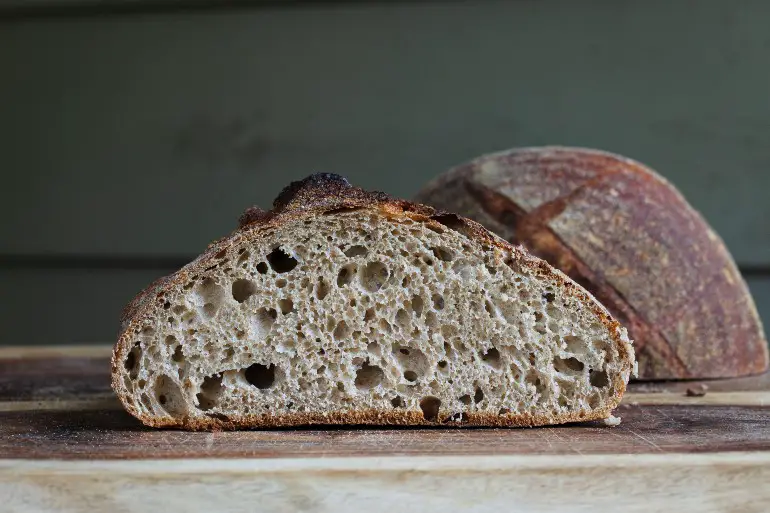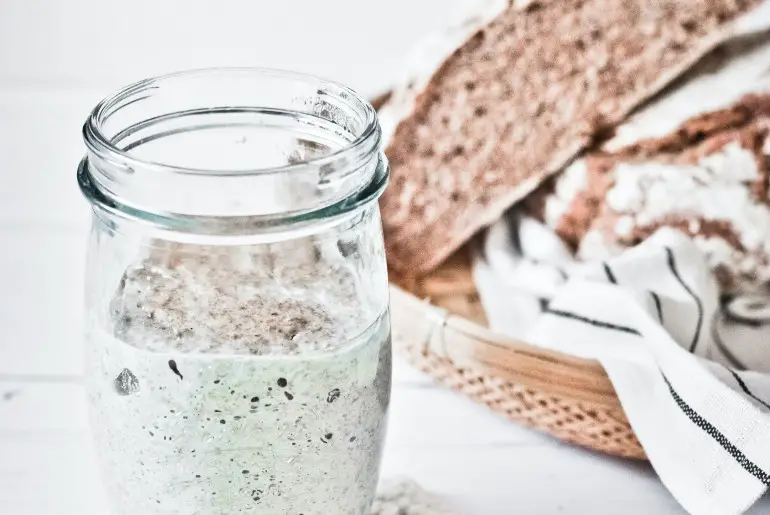What is Sourdough Bread?
Sourdough is a delicious artisan bread that has grown in popularity recently. It has become a trend to make sourdough at home instead of buying it from a bakery. So let’s talk a little more about what sourdough bread is.
The main feature of sourdough bread is that it doesn’t use yeast for leavening (leavening is the process of incorporating air, so bread rises). Instead, sourdough “starter” leavens the bread. This fermented water and flour mixture takes several weeks to make and contains natural yeast, which acts as a leavener. A sourdough starter takes several weeks of “feeding” and maintenance to be able to use. Traditionally, sourdough contains a sourdough starter, flour, water, and salt.
What is the Difference Between Sourdough and Regular Kneaded Bread?
1. Leavening
Sourdough relies on a starter for leavening. The starter begins as flour and water and is allowed to ferment. The water activates the bacteria and yeast. As part of the fermentation process, the starches in the flour break down into glucose (sugars) which feeds the yeast naturally found in the flour. This fermented starter creates the air bubbles needed to leaven sourdough bread.
Regular kneaded bread gets its leavening from yeast added to the dough. Typically, these bread recipes call for a sweetener such as honey or sugar to “feed” the yeast. The yeast then creates CO2, which is the air bubbles that make bread rise. The kneading process is also essential as it aligns the gluten proteins to give kneaded bread the necessary structure to hold the air bubbles, making the bread light and airy inside.
2. Time and Baking Method
It can take several weeks to get a mature sourdough starter. Sourdough bread can also take anywhere from several hours to overnight to rise correctly. Typically sourdough bread is either baked in a dutch oven or on a baking sheet.
Kneaded bread can take an hour or two to rise but doesn’t require the time commitment of nurturing a starter like sourdough bread. It is also usually baked in a bread pan rather than a dutch oven or on a baking sheet.
3. Taste and Texture
Sourdough bread has “sour” in the name for a reason. Sourdough has a unique tart flavor that is similar to the tang of yogurt. The fermented starter is what gives sourdough its tart flavor. Sourdough bread also has a thick, chewy crust, and the inside has large, irregular air pockets.
Kneaded bread should not have a sour flavor. However, it is still very flavorful with a slight yeasty taste. Kneaded bread has a relatively thin, slightly crispy crust. The air pockets in kneaded bread are much smaller and more regular than in sourdough bread. A great example of this is my cinnamon swirl bread.
4. Ingredients
Sourdough bread has a simple ingredient list comprised of sourdough starter, flour, water, and salt. A loaf of kneaded bread also has flour, water, and salt but contains yeast for leavening instead of the fermented starter. Kneaded bread also contains vegetable oil and a sweetener such as sugar or honey.

Is Sourdough Healthy?
Whether something is “healthy” can be a bit of a tricky question. In moderation, all foods can be a part of a healthy diet. However, sourdough bread is generally more nutritious than regular bread because it contributes to gut health, minerals from the flour are better absorbed, and doesn’t increase blood sugar as much.
Sourdough Bread and Gut Health
Sourdough starter has naturally occurring bacteria. The main group of fermenting bacteria in sourdough is lactobacilli. In general, lactobacilli are beneficial probiotics that help your gut. Probiotics are beneficial bacteria.
Lactobacilli produce lactic acid, and this acidity can help minimize the number of harmful bacteria that can grow in your gut. In addition, there is evidence that a healthy gut microbiome (bacteria colony) can benefit your immune system, promote weight loss and improve digestion.
It is even more beneficial if you choose sourdough bread made with whole wheat flour. This will give additional fiber, which helps prevent bloating and promotes regularity. Whole grain flour also provides some prebiotics. Prebiotics are a type of fiber that your body doesn’t digest. Your gut bacteria ferment this fiber, and it helps healthy gut bacteria thrive.
Mineral Absorption from Sourdough Bread
Wheat flour, especially whole wheat flour, contains several B vitamins and minerals (including potassium, magnesium, and zinc). However, they are hard for your body to use because of the amount of phytic acid in wheat flour. Phytic acid blocks your body from absorbing all of these nutrients.
Some bacteria found in sourdough bread create an enzyme (a protein that helps specific reactions occur) called phytase. Phytase breaks down phytic acid. Sourdough is also somewhat acidic, and this decreased pH also helps with phytic acid breakdown. The reduced amount of phytic acids in sourdough means your body can better use the nutrients in the bread.
Sourdough Bread and Blood Sugar
Glycemic index (GI) is a measure of how much a food increases your blood sugar. Low GI foods have a GI less than 55, and a high GI is anything higher than 70. In general, you want to avoid eating a lot of foods with a high GI.
The sourdough fermentation process produces various acids. These acids slow down your body’s absorption of carbohydrates. You also don’t absorb as much of the carbohydrates. Because of this, sourdough will have less of an effect on your blood sugar. Sourdough bread has a GI of about 54 (low GI), while regular bread has a GI of 71 or more (high GI). So if you’re going to eat bread, sourdough is a healthier choice, especially for individuals with prediabetes or diabetes.
I will say that there can be too much of a good thing, and it is always good to consume all things in moderation. It is also important to consider what you are putting on your sourdough as jams and jellies usually contain large amounts of sugar.

What is Sourdough Starter?
You can purchase a live sourdough starter that is pretty much ready to be used as soon as you get it. You can also buy a dried sourdough starter that needs a couple of days of care to make it useable. However, if you don’t want to purchase a sourdough starter, you can make your own.
Making your sourdough starter starts with flour and water. Then you continue to “feed” your starter with flour and water as it grows while discarding excess starter. The sourdough starter needs to be fed twice daily and can take several weeks to mature enough to be used for bread.
Once the starter is mature, it still needs to be fed and will continue to grow. If you’re not making bread almost daily, it may not make sense to continue feeding it and using up flour. In that case, it can be stored in the fridge and kept without feeding for about one week. Then you can revive and bring your starter back to its proper activity so that you can bake with it. For a full article on how to make your own sourdough starter, I recommend checking out this article.
Happy baking!






